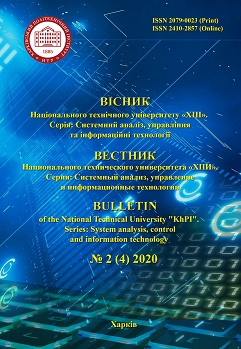FRAMEWORKS ANALYSIS AND EVALUATION USED IN THE WEB-APPLICATION DEVELOPMENT
DOI:
https://doi.org/10.20998/2079-0023.2020.02.08Keywords:
software, framework, Back-End, web applications, quality assessment, assessment criteriaAbstract
This article presents the approaches used to analyze and evaluate modern frameworks that are used in the development of web applications. The analysis and evaluation of frameworks allow you to choose the framework that can be most efficaciously used for each specific case of software development. The popularity of using frameworks in the development of web applications is due to a significant reduction in the time and other resources spent on project execution. The article describes the concept of a framework as a technology for developing web applications and the classification of frameworks. Five main types of frameworks are briefly described. Criteria for the rationality of using frameworks for developing a web application are considered. The advantages and disadvantages of using them when creating web-oriented software are given. When evaluating web applications according to COCOMO model, software options were considered with the use of frameworks in development, and without the use of frameworks. This article provides an overview of the families of modern Back-End frameworks. A comparison of the functionality of the Back-End frameworks of six manufacturers for commercial software solutions is carried out. The choice of criteria for assessing the quality of frameworks is examined. As a basis, when choosing quality criteria, it is proposed to use the ISO 25010 standard. The coefficients of importance for the evaluation criteria, the values of which were obtained with the help of experts, are given. When forming the final assessment of the frameworks, such characteristics as functional suitability, security of working with data, modifiability, interface quality, interaction with payment systems, and integration with JIRA, compatibility, productivity were mentioned. General quality scores were obtained for all the frameworks under consideration. Assessing the quality of frameworks allows you to improve the process of developing a web-oriented software product, the purpose of which is to obtain a web application of a given quality.References
Moseley D., Baumfield V., Elliott J., Gregson M., Higgins S., Miller J., Newton D. P. Frameworks for Thinking: A Handbook for Teaching and Learning. Cambridge, Cambridge University Press, 2006. 378 p.
Clavijo D. Web framework types. Available at: http://blog.websitesframeworks.com/2013/02/web-frameworkstypes-122 (accessed: 19.09.2020).
Stanojević V., Vlajić S., Milić M., Ognjanović M. Guidelines for framework development process. Serbia, 2011 7th Central and Eastern European Software Engineering Conference (CEE-SECR), 2011, №12692778, pp. 1–9.
S. Bhargava., P. J. Bhatewara. Software Engineering: Conceptualize. New Delphi, Educreation Publishing, 2018. 147 p.
Official site SAP Hybris. Available at: https://www.sap.com (accessed 15.09.2020).
Official site Cloud IBM. Available at: https://cloud.ibm.com (accessed 15.09.2020).
Official site Oracle. Available at: https://www.oracle.com (accessed 15.09.2020).
Official site Salesforce. Available at: https://www.salesforce.com (accessed 15.09.2020).
Official site Magento. Available at: https://magento.com (accessed 15.09.2020).
Sravnenie e-commerce platform dlya internen-magazina [Comparison of e-commerce platforms for online shopping]. Available at: http://novardis.com/press/vybor-sravnenie-platforminternet-magazina-hybris.html (accessed 12.10.2020).
ISO/IEC 25010. Available at: http://iso25000.com/index.php/en/iso25000-standards/iso-25010 (accessed 19.09.2020).
Zadeh L. A. Fuzzy Sets. Information and control. 1965, vol 8, pp. 255-353.
Downloads
How to Cite
Issue
Section
License
Copyright (c) 2020 Bulletin of National Technical University "KhPI". Series: System Analysis, Control and Information TechnologiesAuthors who publish with this journal agree to the following terms:
- Authors retain copyright and grant the journal right of first publication with the work simultaneously licensed under a Creative Commons Attribution License that allows others to share the work with an acknowledgement of the work's authorship and initial publication in this journal.
- Authors are able to enter into separate, additional contractual arrangements for the non-exclusive distribution of the journal's published version of the work (e.g., post it to an institutional repository or publish it in a book), with an acknowledgement of its initial publication in this journal.
- Authors are permitted and encouraged to post their work online (e.g., in institutional repositories or on their website) prior to and during the submission process, as it can lead to productive exchanges, as well as earlier and greater citation of published work (See The Effect of Open Access).


